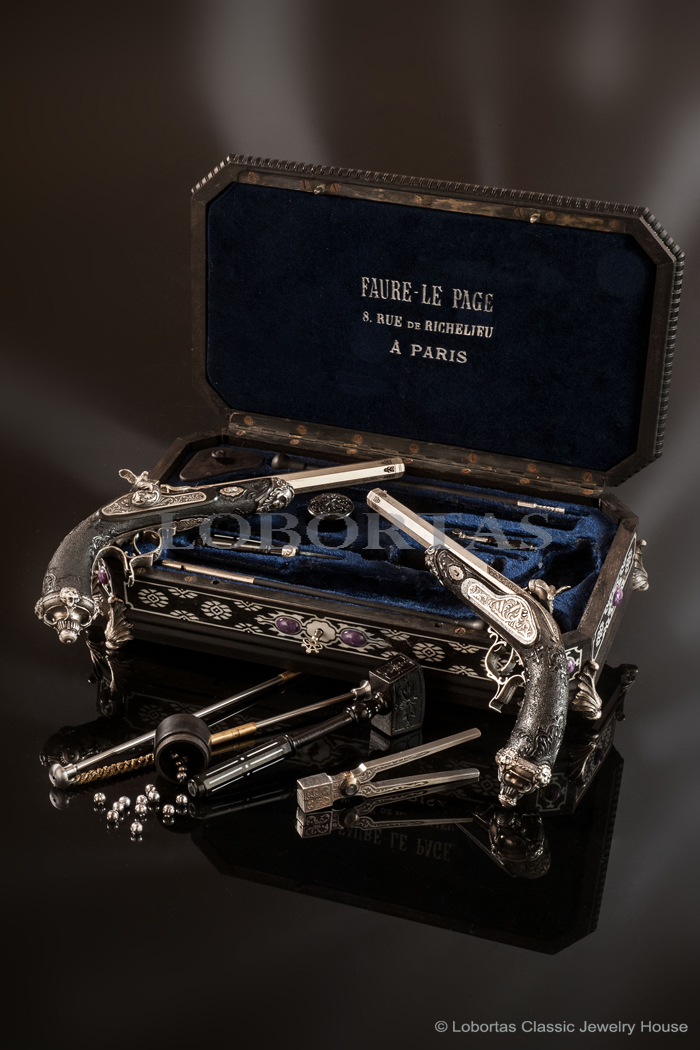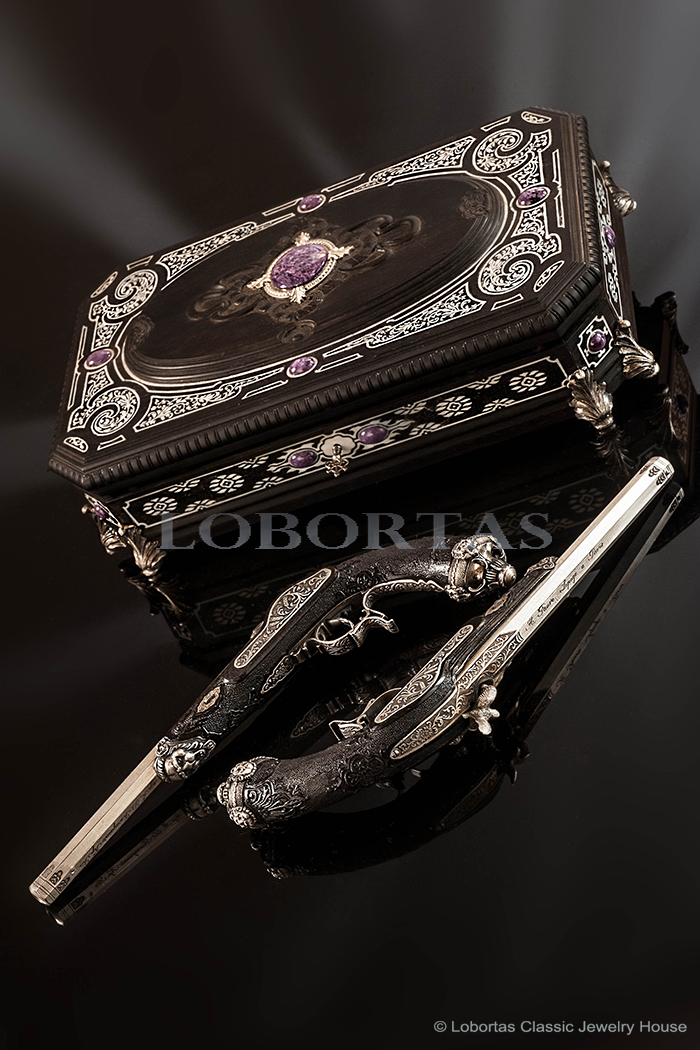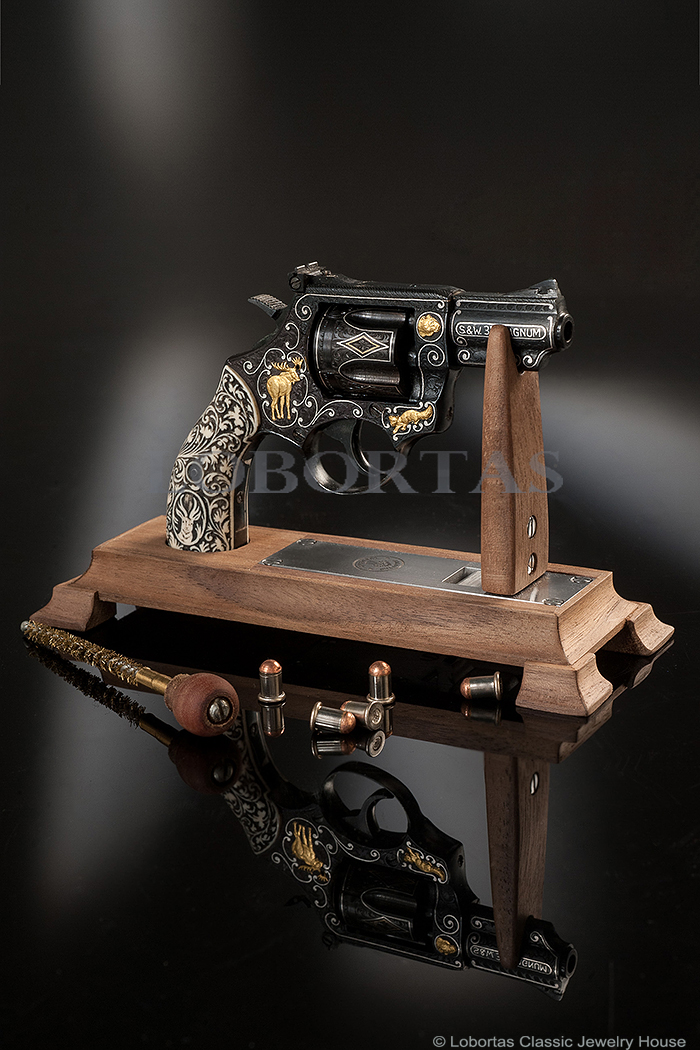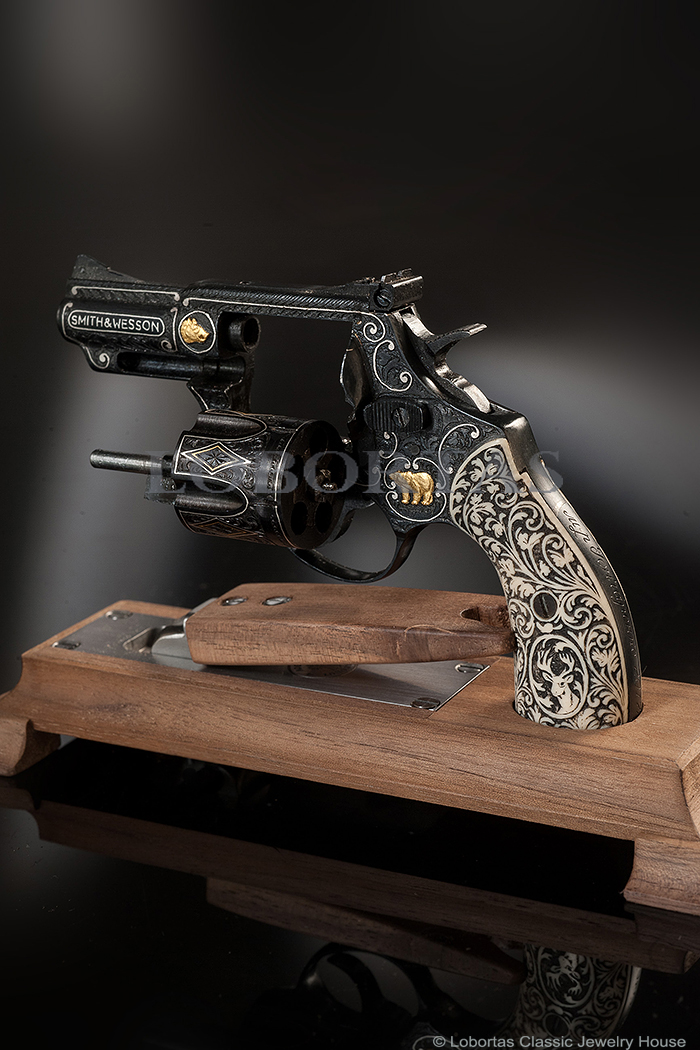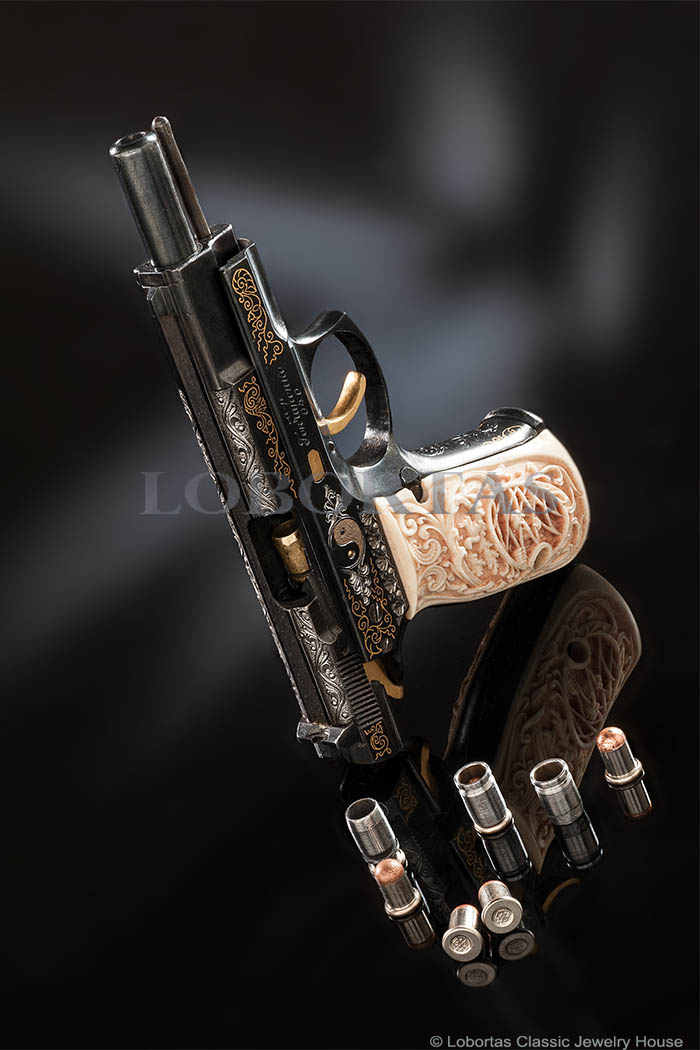Masterpieces of the Miniature Firearms
Artisans of different countries create miniature firearms. Despite the complexity of the manufacture of such masterpieces, a lot of experts are engaged in this area. The creation of any piece of miniature firearms is a very complex process, and therefore even several artisans can work on one project for many months in a row. In addition, if an artisan makes a piece of miniature firearms on his own, the process can be delayed for a very long time.
Winchester model 1866 - Yellow Boy. Scale 1:2,5.
Steel, brass, wood, gilding 999.9.
It is made to use 4mm Ball Flobert ammunition produced by the German company Dynamit Nobel.
Lobortas House
In the process of creating a miniature weapon, an artisan or a team of artisans has to deal not only with the manufacture of metal parts and ammunition, to work with different types of wood, decorative designing of miniature copies, and the solution of many engineering and technical problems, often by developing new versions of internal mechanics. Interestingly, the number of participants in the manufacture of a new miniature masterpiece does not always lead to the acceleration of work.
A set of 2 paired pistols from the Manufacture d'armes de Versailles by N. N. Boutet. Michel Lefaivre.
Scale: 1:2.5. Functional model.

Miniature hunting rifle of Prince Eugène de Beauharnais from the Manufacture d'armes de Versailles by N. N. Boutet. Michel Lefaivre. Scale 1:3. 2003. The full-size model is the property of the Louvre Museum and is exhibited in the Museum of Hunting and Nature at the Hotel de Guénégaud in Paris. Gold engraving and inlay: Yves Sampo, Paris. Wood carving (ebony and walnut): M. O. F. Patrick Blanchard, Paris. Weapon notch: A. Pirrera, Saint-Etienne.
Michel Lefaivre is a French artisan to create miniature firearms. Michel fell in love with miniature models of various vehicles in early childhood, clearly distinguishing the model of the highest quality from the mediocre ones. Michel began his first attempts to make models at the age of 12. He carved wood articles – a car, a plane, a boat. Later, Michel began to make more complex models of wood – much more and more complex models. At the same time, the weapons fascinated Michelle, knowing that the firearms is a key element of the history.
Michel Lefaivre at work | Navy Luger P-08. Michel Lefaivre. Scale 1: 2.5. 2008
By his age of 22, Michel Lefaivre, by having obtained appropriate education in engineering school in Paris, becomes mechanical engineer. Two years of military service from 1962 to 1963, in the armored regiment, further increased Michel's interest in weapons, especially pistols.
Navy Luger Р-08. Michel Lefaivre. Scale 1: 2.5. 2008
Michel Lefaivre tells the following things about his hobby, "The miniature fever was upon me when in the sixties I visited the Science Museum in London and saw all the working steam and diesel engine scale models. I was so impressed by all these masterpieces that I wanted to do something similar applied to handguns myself. I knew I was capable of it, being already a good mechanical fitter. So, for testing my ability to make miniature arms, I started making a simple flintlock mechanism in 1/3 scale and then the complete pistol. As I was proud of the result, I made a second model of the same pistol to have a pair. Since that time, I have always desired to do better and better and have improved my skill on each project. The terms ‘Outstanding, Top quality, Museum quality, Masterpiece’ were my objectives."
Mauser 98K, model 1934. Michel Lefaivre. Scale 1:3. 2010. 2mm Kolibri.
One of the latest firearms miniatures, made by Michel Lefaivre, is a miniature of the famous German rifle Mauser 98K, made in scale 1:3, in great detail repeating the original, working as its full-size model, in strict accordance with the Original drawings of the Arsenal.
Mauser 98K, model 1934. Michel Lefaivre. Scale 1:3. 2010. 2mm Kolibri.
One of the world centers of development and production of weapon miniatures is the Russian city of Tula. It is noteworthy that the Tula masters began to make smaller guns and pistols almost simultaneously with their full-size combat counterparts, in confirmation of their skills, as well as in competition with fellow gunsmiths creating smaller copies of existing systems. Despite other dimensions, the miniature had to have a workable mechanics and skillful finishing.

Flintlock pistol. S. P. Arkhipov. 1996. Cal. 4 mm. The length – 8.1 cm. Scale 1:4.
Stanislav Petrovich Arkhipov is one of such artisans. All weapon miniatures of the Tula master were always functional. The current model of the flintlock pistol, which was in service with the Life Guard Horse Regiment, was made by Stanislav Arkhipov in 1996. To create miniature firearms, the artisan used steel, wood and brass. By constantly improving his skills, Stanislav Petrovich has created many interesting weapon miniatures, some of which are placed in the weapon museums, which speaks of high professionalism.

Mosin–Nagant rifle model 1891. S. P. Arkhipov. 2009. Cal. 3 mm. The length – 31 cm. Scale 1:4.
In 2009, Stanislav Petrovich made a miniature copy of a working rifle model 1891/30 with a bayonet, an additional ramrod, five cartridges in a case. Material – wood and steel.
Mosin–Nagant rifle model 1891. S. P. Arkhipov. 2012. Scale 1: 3.
Photo By Vladislav Filin. Lobortas House.
Gunsmith Alexander Goncharenko creates miniature firearms original and unsurpassed in their technical characteristics. All miniature firearms created by Alexander Dmitrievich are functional, and the main distinguishing feature is the fact that the artisan uses .22 BB Cap cartridges for his mini-firearm masterpieces.
Thompson submachine gun. A. D. Goncharenko Scale 1:2
Photo by Vladislav Filin. Lobortas House.
When being a child, Sasha Goncharenko cut his first mini-firearm out of wood, making a lasting impression on his peers. He now was the first one to be called for playing "war games". And when he inadvertently saw a real sword made of Damascus steel with sheath of extraordinary beauty at his friend, Sasha took it without hesitation, providing himself a lot of evenings of exciting activity – he was closely examining every curve and etching of the mysterious bladed weapon. Nevertheless, Alexander's passion and the dream wish was firearms at that time.
The Faure-Le Page duel couple. A. D. Goncharenko. Scale 1:2.
The original is located in the State Historical Museum of Moscow.
Photo By Vladislav Filin. Lobortas House.
Much later, Alexander Goncharenko caught the eye of an article and a photo about the gunsmith, who managed to convey the extreme similarity of the manufactured gun with the original in a reduced form. "Wow!" Alexander thought dreamily then. "So what if I try?." Fascinated, he looked at the photograph depicting the palm of an unknown artisan, on which 6 mini-weapons rested: the PPSh-41 submachine gun, a Kalashnikov rifle, a TT pistol, a pair of flintlock pistols. In Soviet times, this was not even allowed to think about, not that dare to take such a reckless step. Moreover, to make a copy, but for the appearance, it was necessary to realize weapon mechanics at least. It was not possible to find a specialized literature on such subjects at that time . "Someday, not now, someday..." his heart calmed him.

Alexander Dmitrievich Goncharenko. A picture from the archive of the House of Lobortas.
Alexander Dmitrievich managed to implement his innermost desires in 1993, after the collapse of the Soviet Union. By this time, having mastered many different specialized professions, having studied the capabilities of milling and turning machines, he was finally able to realize a childhood dream that did not leave him for a second.
Revolver Smith & Wesson. Scale 1:2.
Steel, indentation (inlay) with 24K gold and .999 silver, fossil ivory.
It was made to use .22 BB Cap ammunition made by the Czech company of Sellier & Bellot.
Lobortas House.
The reduced dimensions of the weapon miniature impose certain restrictions, which is why a reduced copy cannot always repeat the design of a full-size original and have the same capabilities. Such problems are caused exclusively by mechanics and physics. There is also a problem with the parameters of small springs.
CZ-75 by A. D. Goncharenko. Scale 1:2. The miniature is capable of automatic shooting.
Photo By Vladislav Filin. Lobortas House.
The main problem in the field of small cartridges for miniatures is the selection of the composition of the propellant. Alexander Dmitrievich, through the use of .22 BB Cap ammunition, managed to create an auto-reload piece of miniature firearm. At the same time, this masterpiece gun is identical to the prototype, both according to its design and principles of operation. The .22 BB Cap cartridge creates enough gases to push the bullet out of the shell, run it through the barrel, and send it out. At the same time, the gas pressure is sufficient for the automation to move the free slide.
Walther P38. A. D. Goncharenko. Scale 1:2. The miniature is capable of automatic shooting.
Photo By Vladislav Filin. Lobortas House
When designing a miniature weapon, the artisan is not bound by any restrictions, and therefore can use the most convenient and optimal solutions. Miniature copy developed by Alexander Dmitrievich, can be assembled and disassembled, loaded and reloaded in such way as the original does it. In addition, trigger mechanism, dimensions and mechanical characteristics of the reduced parts of the miniature firearm, correspond to the loads arising during shooting.
The Stechkin automatic pistol. A. D. Goncharenko. Scale 1:2
Photo by Vladislav Filin. Lobortas House.
"Everything I do, I do, first of all, for myself. I need it for my personal self-improvement. You can not imagine how exciting to see, say, Colt Single Action Army first in all its frightening beauty (even as an illustration in the book), and then reduce its scale by three to five times, to get a working mini-copy, which can easily lay on the palm," Alexander tells so about making of his masterpieces of miniature firearms.
PPD-40 Degtyaryov Submachine Gun. A. D. Goncharenko. Scale 1:2.
The miniature is capable of automatic shooting.
Lobortas House.

.jpg&width=430&height=293&quality=80&ratio=1&crop=0&crop_factor=50&thumbdetail=0)
.jpg&width=430&height=293&quality=80&ratio=1&crop=0&crop_factor=50&thumbdetail=0)
.jpg&width=430&height=293&quality=80&ratio=1&crop=0&crop_factor=50&thumbdetail=0)
.jpg&width=430&height=293&quality=80&ratio=1&crop=0&crop_factor=50&thumbdetail=0)
.jpg&width=430&height=293&quality=80&ratio=1&crop=0&crop_factor=50&thumbdetail=0)
.jpg&width=430&height=293&quality=80&ratio=1&crop=0&crop_factor=50&thumbdetail=0)
.jpg&width=400&height=400&quality=80&ratio=1&crop=0&crop_factor=50&thumbdetail=0)
.jpg&width=400&height=400&quality=80&ratio=1&crop=0&crop_factor=50&thumbdetail=0)
.jpg&width=430&height=293&quality=80&ratio=1&crop=0&crop_factor=50&thumbdetail=0)
.jpg&width=430&height=293&quality=80&ratio=1&crop=0&crop_factor=50&thumbdetail=0)
.jpg&width=430&height=293&quality=80&ratio=1&crop=0&crop_factor=50&thumbdetail=0)
.jpg&width=430&height=293&quality=80&ratio=1&crop=0&crop_factor=50&thumbdetail=0)
.jpg&width=430&height=293&quality=80&ratio=1&crop=0&crop_factor=50&thumbdetail=0)
.jpg&width=430&height=293&quality=80&ratio=1&crop=0&crop_factor=50&thumbdetail=0)
.jpg&width=430&height=293&quality=80&ratio=1&crop=0&crop_factor=50&thumbdetail=0)
.jpg&width=430&height=293&quality=80&ratio=1&crop=0&crop_factor=50&thumbdetail=0)
.jpg&width=430&height=293&quality=80&ratio=1&crop=0&crop_factor=50&thumbdetail=0)
.jpg&width=430&height=293&quality=80&ratio=1&crop=0&crop_factor=50&thumbdetail=0)


